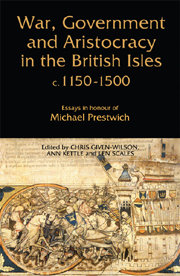 War, Government and Aristocracy in the British Isles, c.1150–1500
War, Government and Aristocracy in the British Isles, c.1150–1500 Book contents
- Frontmatter
- Contents
- List of Contributors
- Introduction
- Abbreviations
- Did Henry II Have a Policy Towards the Earls?
- The Career of Godfrey of Crowcombe: Household Knight of King John and Steward of King Henry III
- Under-Sheriffs, The State and Local Society c.1300–1340: A Preliminary Survey
- Revisiting Norham, May–June 1291
- Treason, Feud and the Growth of State Violence: Edward I and the ‘War of the Earl of Carrick’, 1306–7
- The Commendatio Lamentabilis for Edward I and Plantagenet Kingship
- Historians, Aristocrats and Plantagenet Ireland, 1200–1360
- War and Peace: A Knight's Tale. The Ethics of War in Sir Thomas Gray's Scalacronica
- The King's Secrets: Richard de Bury and the Monarchy of Edward III
- Budgeting at the Medieval Exchequer
- Recent Scholarship on Crusading and Medieval Warfare, 1095–1291: Convergence and Divergence
- The Military Ordinances of Henry V: Texts and Contexts
- Chivalry and English Kingship in the Later Middle Ages
- Cloth of Gold and Gold Thread: Luxury Imports to England in the Fourteenth Century
- Bibliography of the Writings of Michael Prestwich
- Index
- Tabula Gratulatoriad
Treason, Feud and the Growth of State Violence: Edward I and the ‘War of the Earl of Carrick’, 1306–7
Published online by Cambridge University Press: 12 September 2012
- Frontmatter
- Contents
- List of Contributors
- Introduction
- Abbreviations
- Did Henry II Have a Policy Towards the Earls?
- The Career of Godfrey of Crowcombe: Household Knight of King John and Steward of King Henry III
- Under-Sheriffs, The State and Local Society c.1300–1340: A Preliminary Survey
- Revisiting Norham, May–June 1291
- Treason, Feud and the Growth of State Violence: Edward I and the ‘War of the Earl of Carrick’, 1306–7
- The Commendatio Lamentabilis for Edward I and Plantagenet Kingship
- Historians, Aristocrats and Plantagenet Ireland, 1200–1360
- War and Peace: A Knight's Tale. The Ethics of War in Sir Thomas Gray's Scalacronica
- The King's Secrets: Richard de Bury and the Monarchy of Edward III
- Budgeting at the Medieval Exchequer
- Recent Scholarship on Crusading and Medieval Warfare, 1095–1291: Convergence and Divergence
- The Military Ordinances of Henry V: Texts and Contexts
- Chivalry and English Kingship in the Later Middle Ages
- Cloth of Gold and Gold Thread: Luxury Imports to England in the Fourteenth Century
- Bibliography of the Writings of Michael Prestwich
- Index
- Tabula Gratulatoriad
Summary
…But in these cases,
We still have judgement here; that we but teach
Bloody instructions, which being taught, return
To plague th'inventor: this even-handed Justice
Commends th'ingredience of our poison'd chalice
To our own lips.
Macbeth, Act 1, Scene VII, lines 2–12.On 10 February 1306, in the church of the Greyfriars in Dumfries, Robert Bruce, earl of Carrick, and his followers slew John Comyn, lord of Badenoch and a leading member of one of Scotland's most powerful families. A rising against the occupying English immediately followed and, on 25 March, Bruce was inaugurated as king of Scots at Scone abbey. Barely three months later, on 19 June, King Robert marched on Perth to confront Aymer de Valence, Edward I's newly appointed lieutenant in Scotland. Yet according to the chronicler Walter of Guisborough, at the ensuing battle at nearby Methven, on Bruce's orders, ‘all the men at arms on horses had a white coat over their armour, so that they appeared to be in white shirts and you could not see who was who or what arms he bore’. In an age when the bearing of arms on shields and heraldic coat armour was both an essential prerequisite of nobility and a pragmatic measure in battle to ensure capture rather than death, such an act was astonishing. It can be seen either an act of solidarity, symbolically substituting personal recognition for a group identity in the cause of liberation, or as a grim measure of desperation because Bruce and his men now feared for their lives.
- Type
- Chapter
- Information
- War, Government and Aristocracy in the British Isles, c.1150–1500Essays in Honour of Michael Prestwich, pp. 84 - 113Publisher: Boydell & BrewerPrint publication year: 2008


